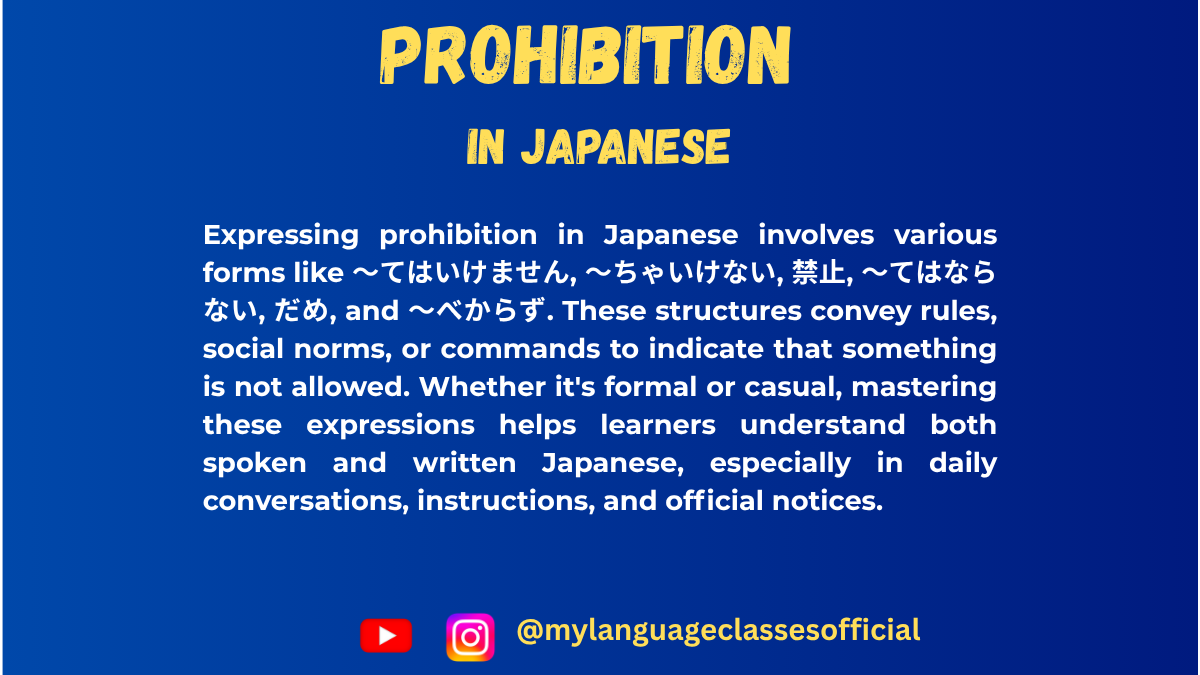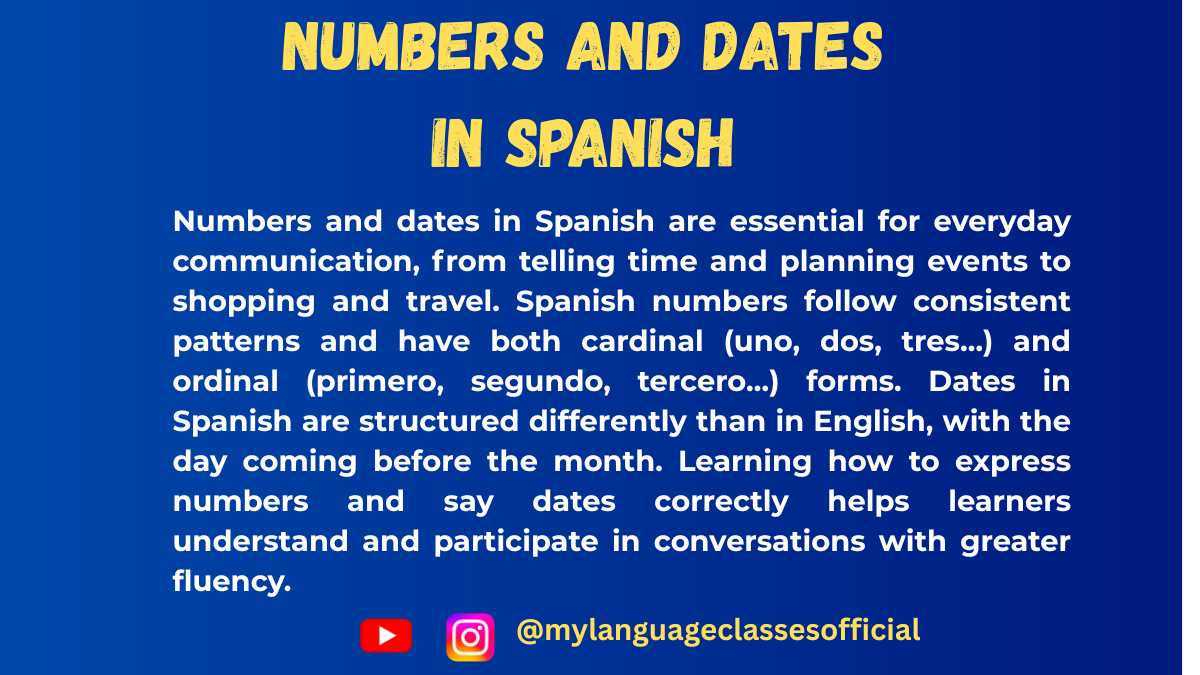Your cart is currently empty!
Tag: travel
-

How to Express Prohibition in Japanese | My Language Classes
Expressing Prohibition in Japanese
If you’re learning Japanese, mastering how to express prohibition (saying what cannot or should not be done) is an essential step toward fluency. Japanese has a rich tapestry of expressions for prohibition, each carrying different nuances based on politeness levels, context, and the strength of the prohibition. In this blog, I’ll guide you through the most common ways to express prohibition in Japanese and help you understand when to use them.
1. ~てはいけません (Te wa ikemasen)
This is one of the most commonly used and polite ways to express prohibition in Japanese. It translates roughly to “You must not…” or “It’s not allowed to…”.
Formation:
Take the te-form of the verb and attach ~てはいけません.
Example:
- ここでたばこを吸ってはいけません。
(Koko de tabako o sutte wa ikemasen.)
“You must not smoke here.”
This phrase is often used in formal situations, such as school rules, workplace guidelines, or signs in public spaces.
2. ~ちゃダメ / ~ちゃいけない (Casual Forms)
In casual settings, Japanese speakers often use ~ちゃダメ or ~ちゃいけない to express prohibition. These are informal contractions of ~てはいけません.
Example:
- ここでゲームしちゃダメだよ。
(Koko de geemu shicha dame da yo.)
“You can’t play games here.” - あそこで走っちゃいけない。
(Asoko de hashiccha ikenai.)
“You must not run over there.”
Use these with close friends, family members, or peers, but avoid them in formal contexts.
3. 禁止 (Kinshi) – The Formal, Written Prohibition
When expressing prohibition in written form, especially on signs or official notices, the word 禁止 (kinshi, meaning “prohibited”) is frequently used.
Example:
- 飲酒禁止 (Inshu kinshi)
“Drinking alcohol is prohibited.” - 駐車禁止 (Chuusha kinshi)
“No parking.”
This construction is direct and impersonal, commonly used in public spaces to state clear rules.
4. ~てはならない (Te wa naranai)
This is a more formal and literary way of expressing prohibition. It is less common in daily conversation but can be seen in legal documents or formal writings.
Example:
- 嘘をついてはならない。
(Uso o tsuite wa naranai.)
“You must not tell lies.”
5. Use of だめ (Dame)
The word だめ (dame) itself means “no good,” “not allowed,” or “forbidden.” It’s highly versatile and can stand alone as an expression of prohibition.
Examples:
- それはだめです。 (Sore wa dame desu.)
“That’s not allowed.” - 今はだめ。 (Ima wa dame.)
“Not now.”
Depending on the tone and situation, だめ can range from strict to soft and conversational.
6. ~べからず (Bekarazu) – Traditional and Strict
This archaic phrase is rarely used in modern conversation but appears in traditional, formal, or poetic contexts.
Example:
- 立ち入りべからず。
(Tachiiri bekarazu.)
“No trespassing.”
It carries an old-fashioned and authoritative tone, reminiscent of samurai-era language.
Choosing the Right Expression
When deciding how to express prohibition in Japanese, consider the following factors:
- Formality: Use ~てはいけません for polite conversations and signs, and ~ちゃダメ for casual settings.
- Authority: Use 禁止 or ~てはならない for official or serious prohibitions.
- Audience: Adapt your language based on whether you’re speaking to a friend, a stranger, or a group.
Practice Makes Perfect!
Understanding prohibition in Japanese is only the first step; using it naturally requires practice. Try creating your own sentences using these structures, and pay attention to how native speakers use them in real life. The more you immerse yourself, the more intuitive these expressions will become.
So, what are you waiting for? Share your practice sentences in the comments, and let’s refine your skills together!
あなたはどの禁止表現をよく使いますか?コメントで教えてください!
(Anata wa dono kinshi hyougen o yoku tsukaimasu ka? Komento de oshiete kudasai!)
Which prohibition expression do you use most often? Let me know in the comments!
If you enjoyed this lesson, be sure to check out more posts like this on my blog at My Language Classes. Don’t forget to subscribe my YouTube channel and follow me on Instagram for the latest language learning tips and lessons. Leave a comment below to share your thoughts, or ask any questions you have about nouns.
Happy learning! 😊
- ここでたばこを吸ってはいけません。
-

Spanish Numbers and Dates
Learning numbers and dates in Spanish is essential for mastering the language, as they are used daily for everything from making appointments to discussing history. In this blog post, we’ll explore the basics of Spanish numbers and dates, along with tips to practice and use them effectively.
Spanish Numbers: The Basics
Cardinal Numbers
Cardinal numbers (números cardinales) are the most basic form of numbers, used for counting. Here’s a quick overview of the key milestones:- 0-10: Cero, uno, dos, tres, cuatro, cinco, seis, siete, ocho, nueve, diez
- 11-19: Once, doce, trece, catorce, quince, dieciséis, diecisiete, dieciocho, diecinueve
- Tens (20-90): Veinte, treinta, cuarenta, cincuenta, sesenta, setenta, ochenta, noventa
- Hundreds and beyond: Cien (100), doscientos (200), mil (1,000), un millón (1,000,000)
Key Tips for Numbers:
- Pronunciation Practice: Numbers like “cinco” (five) and “siete” (seven) can trip up non-native speakers. Practice listening and repeating them to get the rhythm right.
- Connector for Numbers Over 30: Spanish uses “y” (and) to connect tens and units, e.g., treinta y cinco (35). However, numbers below 30 are written as a single word, like veintidós (22).
Dates in Spanish
Understanding how to talk about dates is vital for everyday conversations. The structure differs slightly from English, so let’s break it down.
The Format
In Spanish, the day comes before the month:
DD/MM/YYYY
For example: 15 de marzo de 2024 (March 15, 2024)Months of the Year
Enero (January), febrero (February), marzo (March), abril (April), mayo (May), junio (June), julio (July), agosto (August), septiembre (September), octubre (October), noviembre (November), diciembre (December)Days of the Week
Lunes (Monday), martes (Tuesday), miércoles (Wednesday), jueves (Thursday), viernes (Friday), sábado (Saturday), domingo (Sunday)Key Tips for Dates:
- Ordinal Numbers: Only use ordinal numbers (e.g., primero for “first”) for the first day of the month. For example, el primero de enero (January 1st). All other days use cardinal numbers: el dos de enero (January 2nd).
- Prepositions: Use de to indicate “of” when saying the full date: el 5 de mayo de 2023.
Practice Makes Perfect
To solidify your understanding of numbers and dates in Spanish, here are some fun activities to try:
- Practice with a Calendar: Choose a calendar in Spanish and try saying the dates aloud.
- Role-Playing Scenarios: Pretend to make appointments or book trips. For example, “¿Qué fecha es hoy?” (“What date is it today?”) or “Mi cumpleaños es el 10 de octubre” (“My birthday is October 10th”).
- Listening Practice: Watch Spanish-language videos or listen to podcasts where dates and numbers are mentioned. Pay close attention to how native speakers pronounce them.
Common Mistakes to Avoid
- Mixing Up Dates: Remember that “3/12/2024” in Spanish means December 3, 2024, not March 12.
- Mispronunciation of Compound Numbers: For example, veintidós (22) is often mispronounced because learners forget the stress on the final syllable.
Learning numbers and dates in Spanish is a rewarding step toward fluency. With consistent practice and attention to the nuances of pronunciation and structure, you’ll be able to confidently use these essential tools in your everyday Spanish conversations. ¡Buena suerte! (Good luck!)
What challenges have you faced with Spanish numbers and dates? Share your experiences in the comments below!
If you enjoyed this lesson, be sure to check out more posts like this on my blog at My Language Classes. Don’t forget to subscribe my YouTube channel and follow me on Instagram for the latest language learning tips and lessons. Leave a comment below to share your thoughts, or ask any questions you have.
Happy learning! 😊
